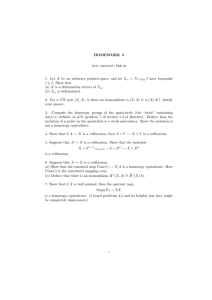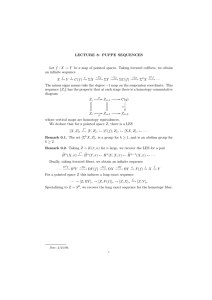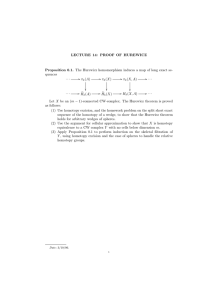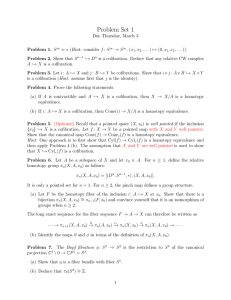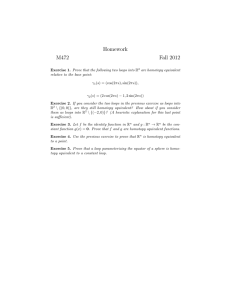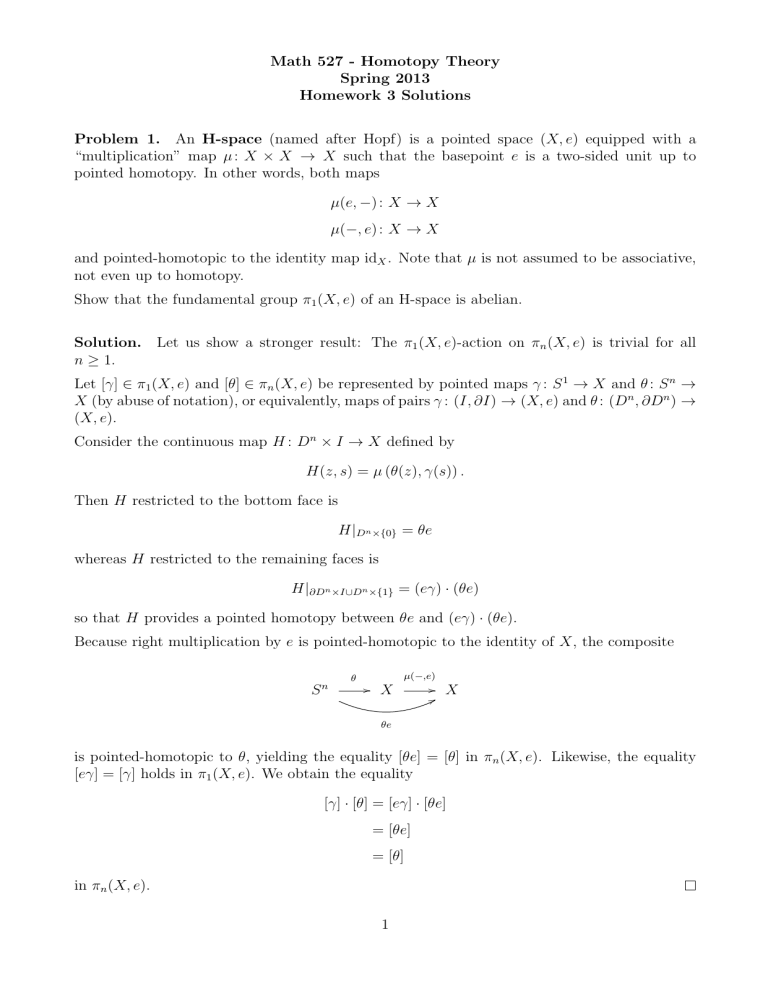
Math 527 - Homotopy Theory
Spring 2013
Homework 3 Solutions
Problem 1. An H-space (named after Hopf) is a pointed space (X, e) equipped with a
“multiplication” map µ : X × X → X such that the basepoint e is a two-sided unit up to
pointed homotopy. In other words, both maps
µ(e, −) : X → X
µ(−, e) : X → X
and pointed-homotopic to the identity map idX . Note that µ is not assumed to be associative,
not even up to homotopy.
Show that the fundamental group π1 (X, e) of an H-space is abelian.
Solution. Let us show a stronger result: The π1 (X, e)-action on πn (X, e) is trivial for all
n ≥ 1.
Let [γ] ∈ π1 (X, e) and [θ] ∈ πn (X, e) be represented by pointed maps γ : S 1 → X and θ : S n →
X (by abuse of notation), or equivalently, maps of pairs γ : (I, ∂I) → (X, e) and θ : (Dn , ∂Dn ) →
(X, e).
Consider the continuous map H : Dn × I → X defined by
H(z, s) = µ (θ(z), γ(s)) .
Then H restricted to the bottom face is
H|Dn ×{0} = θe
whereas H restricted to the remaining faces is
H|∂Dn ×I∪Dn ×{1} = (eγ) · (θe)
so that H provides a pointed homotopy between θe and (eγ) · (θe).
Because right multiplication by e is pointed-homotopic to the identity of X, the composite
S
n
θ
/
µ(−,e)
X
/
7
X
θe
is pointed-homotopic to θ, yielding the equality [θe] = [θ] in πn (X, e). Likewise, the equality
[eγ] = [γ] holds in π1 (X, e). We obtain the equality
[γ] · [θ] = [eγ] · [θe]
= [θe]
= [θ]
in πn (X, e).
1
Problem 2. Let f : X → Y be a map of spaces, and x ∈ X any basepoint. Show that the
induced map
πn f : πn (X, x) → πn (Y, f (x))
for n ≥ 1 is a map of π1 -modules, in the sense that it is π1 f -equivariant. More precisely, for
any γ ∈ π1 (X, x) and θ ∈ πn (X, x) the equation
(πn f )(γ · θ) = (π1 f )(γ) · (πn f )(θ)
holds in πn (Y, f (x)).
Solution. The equation to be proved can be written as the commutative diagram
•
/
π1 (X, x) × πn (X, x)
π1 f ×πn f
•
π1 (Y, f (x)) × πn (Y, f (x))
πn (X, x)
/
(1)
πn f
πn (Y, f (x))
•
− πn (X, x) is obtained by applying the functor
Recall that the action map π1 (X, x) × πn (X, x) →
op
[−, X]∗ : Top∗ → Set∗ to the coaction map c : S n → S 1 ∨ S n .
The map f : (X, x) → (Y, f (x)) in Top∗ yields the postcomposition natural transformation
f∗ : [−, X]∗ → [−, Y ]∗ . Applying f∗ to the coaction map c yields the commutative right-hand
square of the diagram
[S 1 , (X, x)]∗ × [S n , (X, x)]∗ o
∼
=
[S 1 ∨ S n , (X, x)]∗
f∗ ×f∗
[S 1 , (Y, f (x))]∗ × [S n , (Y, f (x))]∗ o
∼
=
c∗
f∗
/
[S 1 ∨ S n , (Y, f (x))]∗
c∗
[S n , (X, x)]∗
/
(2)
f∗
[S n , (Y, f (x))]∗
where the left-hand square also commutes, since the wedge is the coproduct in Top∗ and in
Ho(Top∗ ). But the outer diagram in (2) is precisely the diagram (1).
2
Problem 3. Let X be the topologist’s sine curve:
1
X = {0} × [−1, 1] ∪ {(x, sin ) | 0 < x ≤ 1}.
x
Consider the map f : S 0 → X which picks out the points (0, 1) and (1, sin 1). Show that this
map f is a weak homotopy equivalence but not a homotopy equivalence.
Solution. Write A = {0} × [−1, 1] and B = {(x, sin x1 ) | 0 < x ≤ 1} with X = A ∪ B where
the union is disjoint. Recall that X is connected (being the closure of the connected subset
B ⊂ R2 ), but not path-connected. The two path components of X are A and B.
f is a weak homotopy equivalence. Write a := (0, 1) ∈ A and b := (1, sin 1) ∈ B, and
S 0 = {∗a , ∗b }, with f (∗a ) = a and f (∗b ) = b. The map f : S 0 → X induces a bijection on the
'
sets of path components π0 f : π0 (S 0 ) −
→ π0 (X) = {[a], [b]}.
Since S n is path-connected for all n ≥ 1, any pointed map α : S n → (X, a) lands inside the
path component A ⊆ X. But A is contractible, so that πn (A, a) = 0 and α : S n → (A, a) is
'
pointed-null-homotopic. This proves πn (X, a) = 0. Therefore πn f : πn (S 0 , ∗a ) −
→ πn (X, a) is an
isomorphism (between trivial groups!) for all n ≥ 1.
'
Likewise, B is contractible, so that πn f : πn (S 0 , ∗b ) −
→ πn (X, b) is also an isomorphism (between
trivial groups) for all n ≥ 1.
f is not a homotopy equivalence. Let g : X → S 0 be any continuous map. Since X is
connected, the image g(X) is connected and is therefore a singleton {∗a } or {∗b }. Hence g
cannot induce a bijection on π0 , and thus f has no homotopy inverse.
3
